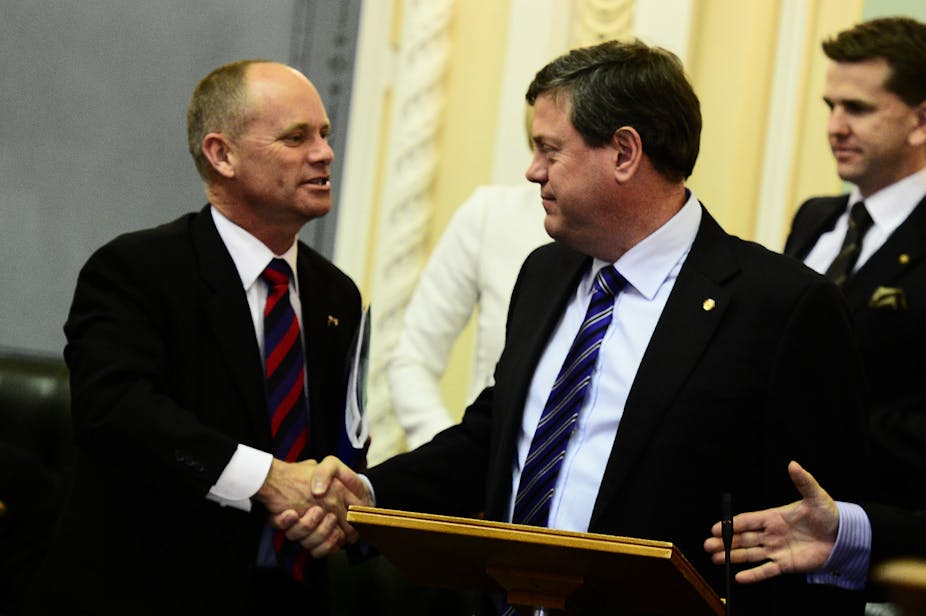As budgets go we’ve seen tougher, but not often.
The first appropriation bill of the Queensland’s new Liberal-National government – the first non-Labor budget in 14 years – was always going to be austere.
As such, there were no surprises on Tuesday. The entire political and economic narrative of the Newman government since its landslide election in March has been one of efficiencies, belt-tightening and public sector sackings. The rationalism of this LNP government hasn’t just been dry, it’s been positively arid.
Premier Campbell Newman, on the heels of the Costello audit into Queensland finances, long warned that Queensland employed 20,000 more public sectors workers than the economy could afford. In the end, job losses came down to a still eye-glazing 14,000 – with about 10,600 actual employees being shown the door and 3,000-odd contracted workers not renewed – in a move that will save around $3.7 billion.
It’s not a lot against a state debt fast approaching $80 billion.
That this budget will bring pain to thousands of families, and uncertainty to many more dependent on public sector activity, is a given. Selling the bad news of job losses, and a potential unemployment rate above 6%, was never going to be easy.
But Treasurer Tim Nicholls, in a sober but confident performance in the chamber, delivered a document that is at least authoritative, and one that meaningfully addresses some core economic problems.
For one, there is a very real and transparent commitment to rein in the debt to revenue ratio, now many times higher than just a few years ago. This is essential before retrieving the state’s much-desired AAA credit rating.
For another, there’s the promise of a real, albeit tiny, surplus in 2013-14, and the expectation that debt will begin to fall by 2014-15. To be able to attain such outcomes in the life of one parliament is admirable.
But what surprised most on Tuesday is the comparatively adroit manner in which this budget was politically framed.
For one, it seems the government is slowly moving away from its “blame Labor” rhetoric – although that will return when expedient – and is now looking to the future.
A touch of populism in sharing pain with the top end of town also won’t bother Campbell Newman. The budget, of course, will see the resources sector bemoan a hike in coal royalties, especially as coal revenues decline. It will also provoke a federal Labor government armed with its own mining tax. But that, and increased stamp duties on houses valued at more than $1 million, should at least keep class envy at bay.
Perhaps most astonishing in this climate is the government’s ability to keep a few more of its election promises. They’ll save the average family only a few hundred dollars a year, but cost of living freezes on electricity and car registration, and a one-off water bill rebate still sweetens an otherwise bitter pill. An additional $147 million to fund the promised 1,100 extra police is also a measure of credibility.
But despite its sound economic and political frames, the Nicholls budget remains open to charges of hypocrisy. In the long lead up to the 2012 state election, the Newman-led LNP Opposition – wary of small target accusations – proudly trumpeted a policy of reviving a four pillar economy around mining, tourism, construction and a long-neglected agricultural sector.
Sadly, this budget does far too little to keep these pillars alive and well, and we can only wonder how central they really are to the Newman-Nicholls vision.
Most glaringly, there’s the apparent contradiction of a government supporting mining, yet simultaneously lumbering the industry with yet another raid on profits. But the outlook is hardly better elsewhere, with tourism receiving a paltry $20 million fillip, and agriculture an even smaller $4.8 million to develop the state as Asia’s “food bowl”. Construction, however, might benefit from the doubling of the first home buyer’s grant for new properties.
The point is that each of these pillars is far more critical to the regions’ economic survival than they are to the southeast. And it is the regions, where a majority of the state’s seats lie, that make and break Queensland governments.
A recessed economy in central, northern and far northern Queensland – where hundreds of thousands of electors this year voted conservative for the first time – is hardly going to sustain an LNP that locals feel is run by Brisbane interests.
This is a problem, especially for Newman, as the new face of economic austerity. While the LNP and its 78 seats can withstand an electoral earthquake, the Premier himself is far more vulnerable in his inner Brisbane seat of Ashgrove – home to large numbers of public servants – and held by just 5.7%.
The irony is that Newman may eventually fall victim to austerities delivered by Nicholls, with the Treasurer assuming the premiership thereafter.
Politics, like finance, can be so unforgiving.

